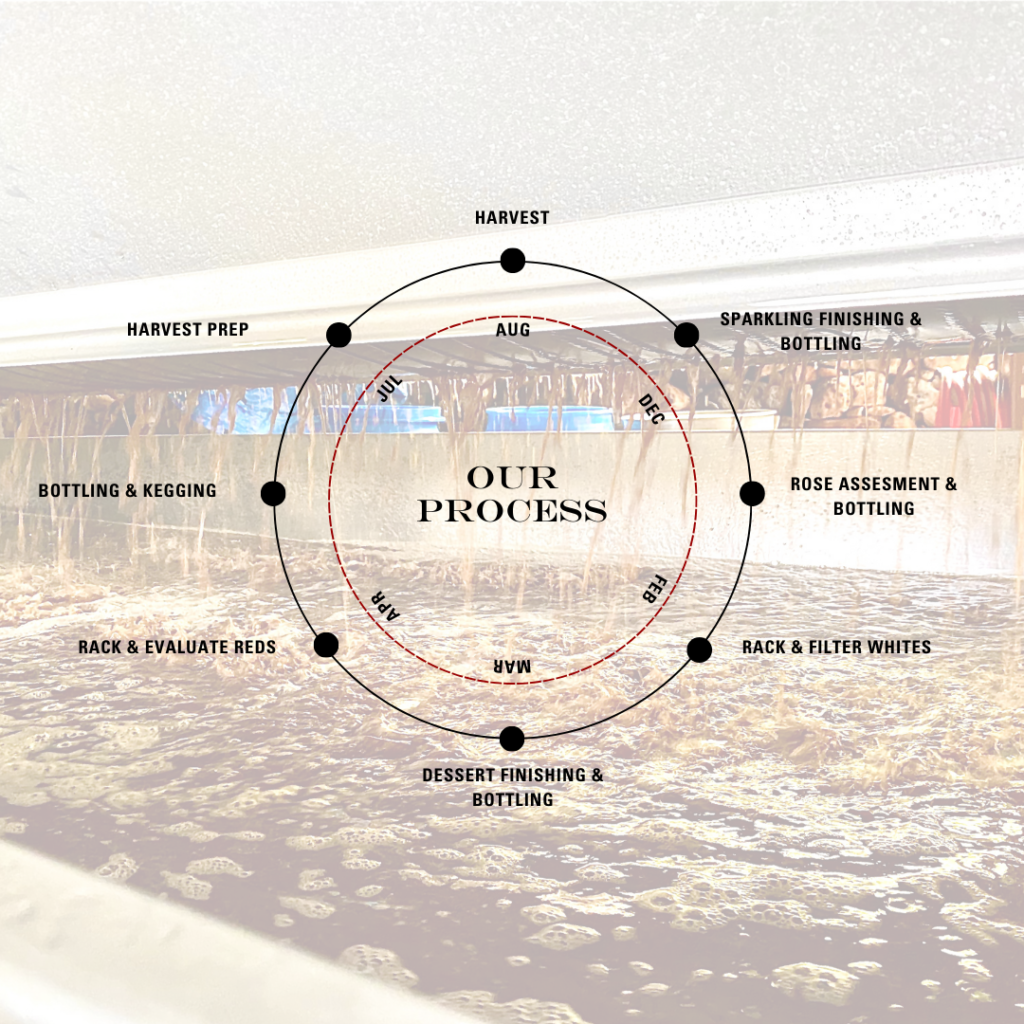15 Mar Winemaking Seasons
Written by Corey Turnbull, Head Winemaker and edited by Brandi Corley, Marketing Director
Our year begins with Harvest, spanning from mid-August to early November. An intense time of year marked by long hours, beautiful sights, smells, and a palpable buzz of excitement. Fermentation, pressing, and initial stylistic decisions are pivotal during this period and guide how the rest of the winemaking year plays out. If you want to get to know us and our winemaking process better during the Harvest season, check out our one-of-a-kind Harvest Tours that take place between August and October.
Following a brief hiatus post-harvest, the focus shifts to completing sparkling wines, which lack the benefit of extended aging. This marks the Sparkling Finishing Season and is when we finalize our Piquettes and Sparkling Apple Wine. At the same time, attention turns to assessing and finalizing our Rose program, where we aim for youthful freshness. Our current Rose offering is the 2022 La Flor Rosa — a delightful, savory, fruity, light, and refreshing wine. Rose bottling typically occurs in February, but due to a delay in cork delivery has been pushed to March this year.
With several tanks now vacant, we proceed to blend and rack client red wines, a process that varies slightly between labels. This phase is relatively brief, usually lasting only a day or two.
Following this, we embark on racking and conducting the initial filtration of white wines. We maintain individual lots, keeping them separate and filtering them back to barrel or transferring them between tanks. The whites then undergo a settling period of one to three weeks to recuperate from the initial filtration.
Around March, we retrieve our dessert wines from Phoenix to thaw and concentrate, marking the onset of Dessert Season. With tanks available, we carefully control temperatures during fermentation, arresting the process when the wines attain the desired sweetness levels. They are then promptly bottled to preserve their freshness.
In April, typically, we start racking reds, meticulously keeping lots distinct and adjusting levels of free sulfur dioxide. These wines then return to the barrel for a brief period before we revisit them for blending trials and final decisions, mirroring the process observed with the whites.
May, June, and July are predominantly reserved for bottling and kegging operations, beginning with the whites followed by lighter reds and culminating with the fuller-bodied reds.
Throughout the initial eight months of the year, we engage in a flurry of logistical activities—ordering, receiving, and depleting bottling supplies, acquiring labels, obtaining COLAs (Certificates of Label Approval), among others. This logistical dance constantly evolves as decisions are made, ensuring a seamless operation.
Overall, the cellar team’s perception of seasons varies, with each presenting its unique challenges and opportunities. The cyclic nature of tasks offers a sense of progression amid the routine, punctuated by the anticipation of transitioning to the next phase. Despite its repetitive nature, winemaking demands adaptability and a diverse skill set to navigate each season’s demands effectively.




 Limited Availability. Add Second Harvest Body Butter to any massage. Locally hand made body butter from PSC pressed grape skins, grape seeds, Shea Butter, Coconut Oil and Grape Seed Oil. Hydrating and healthy for your skin, subtle nutty aroma. $5/60 minute massage $7/90 minute massage.
Limited Availability. Add Second Harvest Body Butter to any massage. Locally hand made body butter from PSC pressed grape skins, grape seeds, Shea Butter, Coconut Oil and Grape Seed Oil. Hydrating and healthy for your skin, subtle nutty aroma. $5/60 minute massage $7/90 minute massage.
Sorry, the comment form is closed at this time.